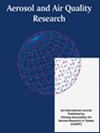银川市雾霾期间细颗粒物化学成分及混合状态
IF 2.5
4区 环境科学与生态学
Q3 ENVIRONMENTAL SCIENCES
引用次数: 0
摘要
本研究对银川市2021年12月21日至31日期间大气细颗粒物的化学组成及混合状态进行了研究。为此,采用了单粒子气溶胶质谱(SPAMS)技术。在整个采样期间,黑碳颗粒是主要的气溶胶类型(就数量分数而言),占所有采样颗粒的61.15%。研究区细颗粒的混合状态发生了较大的变化。此外,还观察到钾粒子明显的质谱特征。正质谱中的39k +信号强于其他信号。在整个采样过程中,富k和钾元素碳(KEC)颗粒分别占全部采样颗粒的25.86%和13.05%,其次是OC和NaKEC,分别占12.32%和11.45%。SPAMS检测到的气溶胶浓度随时间变化的复杂过程。元素碳/有机碳(ECOC)和KEC颗粒的数量分数在污染日显著高于清洁日。与EC和NaKEC相比,ECOC和KEC颗粒与硫酸盐和硝酸盐的混合程度更高。与洁净日相比,污染日各BC颗粒的粒径均有所增大。ECOC和KEC颗粒比EC和NaKEC颗粒粒径更大,硫酸盐和硝酸盐信号更强,表明ECOC和KEC颗粒主要是在时效过程中形成的。局部污染事件与一次燃烧排放和二次颗粒产生有关。本文章由计算机程序翻译,如有差异,请以英文原文为准。
Chemical Composition and Mixing State of Fine Particles during Haze Periods in Yinchuan
In this study, we explored the chemical composition and mixing state of fine atmospheric particles in Yinchuan between December 21 and 31, 2021. For this, the single-particle aerosol mass spectrometry (SPAMS) technique was used. Black carbon particles were found to be the predominant aerosol type (in terms of number fraction) throughout the sampling period, accounting for 61.15% of all sampled particles. Considerable changes were noted in the mixing state of the fine particles in the study area. Furthermore, prominent mass spectrum characteristics of potassium particles were observed. The 39 K + signal in the positive mass spectrum was stronger than the other signals. Throughout the sampling process, K-rich and potassium-elemental carbon (KEC) particles accounted for 25.86% and 13.05% of all sampled particles, respectively, followed by OC and NaKEC, which accounted for 12.32% and 11.45%, respectively. With time, complex processes of aerosol concentration variation detected by SPAMS were observed. The number fractions of elemental carbon/organic carbon (ECOC) and KEC particles were significantly higher on polluted days than on clean days. ECOC and KEC particles were more mixed with sulfate and nitrate than EC and NaKEC particles. Compared with clean days, the particle size of each BC particle increased on polluted days. Furthermore, ECOC and KEC particles had larger particle sizes and stronger sulfate and nitrate signals than EC and NaKEC particles, which indicates that ECOC and KEC particles were mostly formed during the aging process. Local pollution events were associated with primary combustion emission and secondary particle generation.
求助全文
通过发布文献求助,成功后即可免费获取论文全文。
去求助
来源期刊

Aerosol and Air Quality Research
ENVIRONMENTAL SCIENCES-
CiteScore
8.30
自引率
10.00%
发文量
163
审稿时长
3 months
期刊介绍:
The international journal of Aerosol and Air Quality Research (AAQR) covers all aspects of aerosol science and technology, atmospheric science and air quality related issues. It encompasses a multi-disciplinary field, including:
- Aerosol, air quality, atmospheric chemistry and global change;
- Air toxics (hazardous air pollutants (HAPs), persistent organic pollutants (POPs)) - Sources, control, transport and fate, human exposure;
- Nanoparticle and nanotechnology;
- Sources, combustion, thermal decomposition, emission, properties, behavior, formation, transport, deposition, measurement and analysis;
- Effects on the environments;
- Air quality and human health;
- Bioaerosols;
- Indoor air quality;
- Energy and air pollution;
- Pollution control technologies;
- Invention and improvement of sampling instruments and technologies;
- Optical/radiative properties and remote sensing;
- Carbon dioxide emission, capture, storage and utilization; novel methods for the reduction of carbon dioxide emission;
- Other topics related to aerosol and air quality.
 求助内容:
求助内容: 应助结果提醒方式:
应助结果提醒方式:


